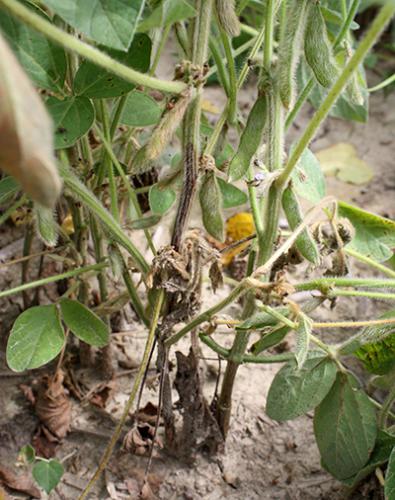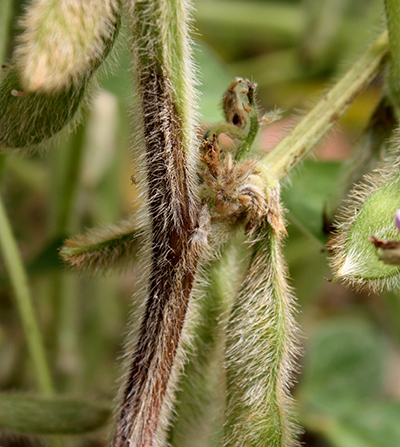Soil samples needed to examine effectiveness of soybean Phytophthora-resistance genes
Statewide soil sampling survey will help growers make decisions on what soybean cultivar to plant in fields with Phytophthora stem and root rot.

The recent, heavy rain events are likely to bring on Phytophthora root and stem rot symptoms (see images). In an effort to improve Phytophthora root and stem rot management, we are conducting a survey to identify races (pathotypes) of Phytophthora sojae.
If you would like to submit a soil sample, please include:
- One gallon of soil sampled from at least 10 different parts of a field known to have a history of Phytophthora root and stem rot.
- GPS coordinates of the field so we can map where each sample came from, or the nearest road intersection. (We recommend using Google maps to obtain GPS points in the field.)
- The date you collected the soil.
- Any information you can give us on field practices used, i.e., tillage practices, irrigation, previous crop planted, etc.
Ship or deliver soil samples to:
Austin McCoy (Chilvers Lab)
Center for Integrative Plant Systems Building
578 Wilson Road Room 104
East Lansing, MI 48824
Phytophthora root and stem rot of soybean, caused by the water mold Phytophthora sojae, is a common disease of soybean that is found in all soybean producing regions. However, low areas with poor drainage or compact soils are the most prone to disease development. Infected plants will appear in clusters or as individuals throughout the field, typically in poorly drained areas.

Symptoms of Phytophthora root and stem rot can be as indistinct as stunted growth or wilt of resistant plants, to susceptible plants exhibiting the distinct brown lesion growing vertically up the stem of plants at any growth stage. This stem lesion will eventually lead to plant death and potentially heavy stand loss. Soybeans typically start showing symptoms in mid- to late July, so the next couple of weeks are pivotal for Phytophthora root and stem rot scouting.
Phytophthora sojae can overwinter within soils as a microscopic spore, the oospore. When soil temperatures rise to over 60 degrees Fahrenheit and free water in the soil is abundant (after heavy rains), these oospores will germinate and produce the infective spore, motile zoospores.
When water is in excess, these zoospores are attracted to root exudates produced by soybean plants and quickly infect. Throughout the growing season, the disease progresses from the roots into the stem of the plant, causing the typical lesion that growers frequently find in fields.
Currently, there are two forms of resistance to Phytophthora sojae: race-specific resistance (Rps) genes and partial resistance. Rps genes confer resistance to specific races (pathotypes) of P. sojae. As these resistance genes are deployed in symptomatic fields, we are seeing a rise in pathotype complexity leading to the ineffectiveness of previously used Rps genes.

Partial resistance is effective against all pathotypes of P. sojae. However, this type of resistance is not expressed until the first true leaves are formed, so seed treatments containing Metalaxyl/Mefenoxam are recommended to decrease pre-emergence stand loss.
Determining what pathotypes are found within Michigan will help soybean breeders identify what Rps genes should be incorporated into cultivars to control our P. sojae populations. Likewise, this study will allow farmers to make an informed decision on what soybean cultivars to plant in fields that have a history of Phytophthora stem and root rot.
To this end, Michigan State University is currently conducting a statewide sampling survey to identify what pathotypes, or races, of Phytophthora sojae are currently found within Michigan. Our goal is to produce an accurate depiction of the pathotype distribution within Michigan to help farmers and breeders determine what Rps genes will work best in the area. We would like support from farmers, crop inspectors and MSU Extension educators to help us sample as many counties in Michigan as possible.
If you have any questions, please contact Austin McCoy at mccoyaus@msu.edu.



 Print
Print Email
Email




